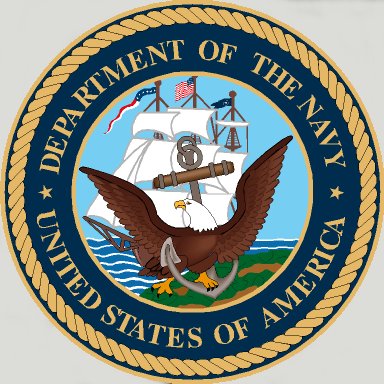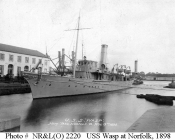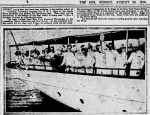NavSource Online:
Patrol Yacht Photo Archive
Wasp
Nan - Watch - Fox | King - Love - Vice - Baker |



Wasp served the U. S. Navy and the Florida and New York Naval Militias
Patrol Yacht:
Specifications:
| Commanding Officers | ||
| 01 | LT Aaron Ward, USN | 11 April 1898 |
| 02 | LT Frederick A. Russell, USNRF | 1918 |
| 03 | LT Clarence A. Moore, USNRF | 1918 - 1919 |
| 04 | LT Wedell Foss, USNRF | 1919 |
|
|
The converted yacht departed New York on 26 April and headed south for duty blockading Cuba. She stopped at Key West, Fla., from 1 to 7 May and arrived off Havana on the latter day. From there, she moved west along the northern coast to Bahia Honda, also arriving there on the 7th. On 12 May, while cruising on blockade station off the Cuban coast between Havana and Bahia Honda, Wasp joined a small convoy escorted by the revenue cutter Manning and made up of the merchantman SS Gussie and the tugs Triton and Dewey. Gussie carried two companies of Army troops scheduled to land at Bahia Honda while Triton and Dewey carried representatives of the press.
Just before 1500 that afternoon, some of the soldiers from Gussie went ashore near Cabanas, purportedly the first American troops to land on Cuban soil. They formed a skirmish line and started their advance through dense underbrush. At about 1515, Spanish forces counterattacked the American troops and opened fire on the ships in the bay. Wasp returned fire with her portside six pounders, carefully avoiding the area occupied by friendly forces. At that point, she received word that the 100 or so soldiers fighting ashore were heavily outnumbered and outflanked to the west. The only course of action open to them was to disengage the enemy and reembark in Gussie. During that operation, Wasp joined Manning and recently arrived Dolphin in providing covering gunfire for the evacuation. When another landing, scheduled for the following day, did not occur, Wasp lobbed a few shells at an adobe watchtower from which Spanish riflemen had taken the ships under fire, and then she resumed her patrol station off the coast.
Two days later, the converted yacht departed the Cuban coast to return to Florida. She arrived at Key West that same day and remained in the Keys, either at Key West or Sand Key, almost until the end of May. Wasp returned to the blockade, at Cienfuegos, briefly on the 29th but was back at Key West on the 31st. During June, the yacht moved from blockade station to blockade station, returning periodically to the Florida Keys for necessities. From 9 to 11 June, she stood off Havana. After a three-day return to Key West, Wasp took station off the southeastern coast of Cuba on 20 June patrolling between Santiago de Cuba and Guantanamo Bay.
At the beginning of July, she paid a five-day visit to Key West, returning to the Santiago area again on 10 July. On the 19th, the converted yacht cleared Guantanamo Bay for Nipe Bay on Cuba's northeastern coast. She arrived at Nipe Bay late on the morning of the 21st and, on orders to reconnoiter the bay in company with Leyden, started in toward Port Nipe. Upon entering, Wasp sighted a Spanish warship at anchor some four miles up the bay. She fired several shots at the signal station located at the entrance; then sped forward to engage the enemy ship. At 1244, the Spanish ship opened fire at extreme range, and Wasp returned fire immediately. Leyden, followed by Annapolis and Topeka, quickly joined in. As the range decreased, American gunfire became more accurate, and all four ships began scoring telling hits on the enemy. Finally, at 1312, the Spaniard's colors disappeared. Wasp and her three colleagues ceased fire and watched their quarry, the cruiser Don Jorge Juan, sink at 1342. After making a complete reconnaissance of the southern and western portions of the bay, Wasp anchored there for the night.
On 23 July, the ship departed Cuba, bound for Puerto Rico, and arrived off Fajardo that same day. For the next seven weeks, she cruised the coasts of Puerto Rico in company with Dixie, Annapolis, and Gloucester. Throughout the entire period, only one noteworthy event occurred. On 27 July, the four ships encountered three Spanish brigantines at Ponce but evaluated them as too insignificant even to take as prizes. On 8 September, Wasp departed San Juan to return to the United States. After a five-day stop at Charleston, she continued her voyage north on the 18th and entered the Norfolk Navy Yard on the 21st. On 27 September, she was decommissioned there and laid up.
On 15 December, the yacht was loaned to the Florida Naval Militia for training purposes. That tour of duty lasted until 21 June 1899 at which time she was returned to the Navy. She resumed her retirement to serve as station ship at Port Royal, S.C. In July 1902, she returned to Norfolk to be decommissioned once again on the 23d.
However, on 2 October, she went into commission again and received orders to the 8th Naval District. During her service there as a district tender, she made infrequent cruises in the Gulf of Mexico and the West Indies. In 1906, she moved from the Gulf of Mexico to Newport, R.I., for a tour of duty at the Torpedo Station. In 1907, she visited east coast, gulf, and Mississippi River ports during a cruise to spur enlistments in the Navy. The following year, Wasp began a nine-year assignment, again training naval militiamen, this time on loan to the New York Naval Militia.
That duty ended early in 1917, as the United States moved closer to war. On 7 April, the day after the American declaration of war on the German Empire, she began patrolling the coast of Long Island. Throughout the first year of the war, the yacht cruised the coastal waters of the 3d Naval District as a unit of, and later as flagship for, Squadron 8, Patrol Force. In April 1918, Wasp received orders detaching her from the 3d Naval District and assigning her to duty at Annapolis, Md. She arrived in Annapolis on 9 May and, but for periodic runs to Norfolk, remained there for the remainder of her naval career. Struck from the Navy list on 13 November 1919, Wasp was formally decommissioned at Norfolk on 1 December 1919. On 20 September 1921, she was sold to Mr. Halsted P. Layton of Georgetown, Del.
| Back to the Main Photo Index | Back to the Patrol Craft/Gunboat/Submarine Chaser Index | Back to the Patrol Yacht (PY) Photo Index |
| Comments, Suggestions, E-mail Webmaster |
|
This page created by Joseph M. Radigan and maintained by Tom Bateman |




